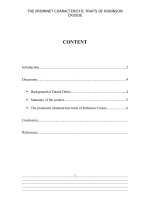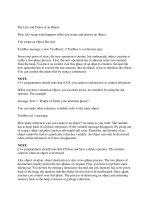Tài liệu The Air Force Chief of Staff Logistics Review - Improving Wing-Level Logistics docx
Bạn đang xem bản rút gọn của tài liệu. Xem và tải ngay bản đầy đủ của tài liệu tại đây (565.94 KB, 212 trang )
This PDF document was made available
from www.rand.org as a public service of
the RAND Corporation.
6
Jump down to document
Visit RAND at www.rand.org
Explore RAND Project AIR FORCE
View document details
This document and trademark(s) contained herein are protected by law
as indicated in a notice appearing later in this work. This electronic
representation of RAND intellectual property is provided for non-
commercial use only. Permission is required from RAND to reproduce, or
reuse in another form, any of our research documents.
Limited Electronic Distribution Rights
For More Information
CHILD POLICY
CIVIL JUSTICE
EDUCATION
ENERGY AND ENVIRONMENT
HEALTH AND HEALTH CARE
INTERNATIONAL AFFAIRS
NATIONAL SECURITY
POPULATION AND AGING
PUBLIC SAFETY
SCIENCE AND TECHNOLOGY
SUBSTANCE ABUSE
TERRORISM AND
HOMELAND SECURITY
TRANSPORTATION AND
INFRASTRUCTURE
The RAND Corporation is a nonprofit
research organization providing
objective analysis and effective
solutions that address the challenges
facing the public and private sectors
around the world.
Purchase this document
Browse Books & Publications
Make a charitable contribution
Support RAND
This product is part of the RAND Corporation monograph series.
RAND monographs present major research findings that address the
challenges facing the public and private sectors. All RAND mono-
graphs undergo rigorous peer review to ensure high standards for
research quality and objectivity.
+RISTIN&,YNCH*OHN'$REW
$AVID'EORGE2OBERT34RIPP
#2OBERT2OLL*R*AMES,EFTWICH
0REPAREDFORTHE5NITED3TATES!IR&ORCE
!PPROVEDFORPUBLICRELEASEDISTRIBUTIONUNLIMITED
4HE!IR&ORCE
#HIEFOF3TAFF
,OGISTICS2EVIEW
)MPROVING7ING,EVEL,OGISTICS
5IF3"/%$PSQPSBUJPOJTBOPOQSPGJUSFTFBSDIPSHBOJ[BUJPOQSPWJEJOH
PCKFDUJWFBOBMZTJT BOE FGGFDUJWF TPMVUJPOTUIBU BEESFTTUIF DIBMMFOHFT
GBDJOH UIFQVCMJD BOE QSJWBUF TFDUPST BSPVOE UIF XPSME 3"/%T
QVCMJDBUJPOTEPOPUOFDFTTBSJMZSFGMFDUUIFPQJOJPOTPGJUTSFTFBSDIDMJFOUT
BOETQPOTPST
¥
JTBSFHJTUFSFEUSBEFNBSL
ª$PQZSJHIU3"/%$PSQPSBUJPO
"MM SJHIUT SFTFSWFE /P QBSU PGUIJT CPPLNBZ CF SFQSPEVDFE JO BOZ
GPSN CZ BOZ FMFDUSPOJD PSNFDIBOJDBM NFBOT JODMVEJOH QIPUPDPQZJOH
SFDPSEJOH PS JOGPSNBUJPO TUPSBHF BOESFUSJFWBMXJUIPVU QFSNJTTJPO JO
XSJUJOHGSPN3"/%
1VCMJTIFECZUIF3"/%$PSQPSBUJPO
.BJO4USFFU10#PY4BOUB.POJDB$"
4PVUI)BZFT4USFFU"SMJOHUPO7"
/PSUI$SBJH4USFFU4VJUF1JUUTCVSHI1"
3"/%63-IUUQXXXSBOEPSH
5PPSEFS3"/%EPDVNFOUTPSUPPCUBJOBEEJUJPOBMJOGPSNBUJPODPOUBDU
%JTUSJCVUJPO4FSWJDFT5FMFQIPOF
'BY&NBJMPSEFS!SBOEPSH
-JCSBSZPG$POHSFTT$BUBMPHJOHJO1VCMJDBUJPO%BUB
5IF"JS'PSDF$IJFGPG4UBGGMPHJTUJDTSFWJFXJNQSPWJOHXJOHMFWFMMPHJTUJDT
,SJTUJO-ZODI
QDN
i.(w
*ODMVEFTCJCMJPHSBQIJDBMSFGFSFODFT
*4#/QCLBMLQBQFS
6OJUFE4UBUFT"JS'PSDF0QFSBUJPOBMSFBEJOFTT6OJUFE4UBUFT"JS'PSDF
4VQQMJFTBOETUPSFT"JSQMBOFT.JMJUBSZ6OJUFE4UBUFT.BJOUFOBODFBOESFQBJS*
-ZODI,SJTUJO**6OJUFE4UBUFT%FQUPGUIF"JS'PSDF$IJFGPG4UBGG
6("
hhED
5IF SFTFBSDI SFQPSUFEIFSFXBT TQPOTPSFECZ UIF6OJUFE 4UBUFT "JS
'PSDFVOEFS$POUSBDU'$'VSUIFSJOGPSNBUJPONBZCF
PCUBJOFEGSPNUIF4USBUFHJD1MBOOJOH%JWJTJPO%JSFDUPSBUFPG1MBOT)R
64"'
iii
Preface
This report describes a review conducted by the Air Force and the
RAND Corporation called the Chief’s Logistics Review (CLR).
Somewhat different from a typical RAND study, this was a joint ef-
fort in which RAND acted as analytic advisor to the Air Force. This
effort was directed, in October 1999, by Gen Michael E. Ryan, then
Chief of Staff of the Air Force (CSAF), to develop improvement
options to mitigate logistics problems that had arisen in the 1990s.
CLR was placed under the overall direction of Gen John W. Handy,
then Deputy Chief of Staff, Installations and Logistics, who asked
RAND to develop the analytic approach for the review, choosing
RAND because of its previous research and the confidence of senior
Air Force leaders.
In response to ongoing concerns about declining readiness
trends in aircraft maintenance, General Ryan directed CLR. In pro-
viding guidance for the review, General Ryan emphasized looking at
process and training deficiencies within existing organizations and
directed that the study focus on identifying actions required to re-
solve such deficiencies. This report provides background material on
CLR and describes both the analytic approach (including RAND’s
role in its development) and the results from this review of Air Force
wing-level logistics processes. The background material covers both
the initial phase of the study, in which the proposed improvements
were determined, and the second phase of the study, in which the
improvements were field tested.
iv The Air Force Chief of Staff Logistics Review: Improving Wing-Level Logistics
This report also provides insights gained through the study that
should be useful to future generations of logisticians, operators, and
planners throughout the Department of Defense, particularly those in
the Air Force, who struggle with the challenges of maintaining the
most ready and capable aircraft fleet in the face of new threats and
resource environments. It may prove useful to such personnel across
the Department of Defense, as well.
The research addressed in this report was conducted in the Re-
source Management Program of RAND Project AIR FORCE. The
Air Force Deputy Chief of Staff, Installations and Logistics,
sponsored this project.
RAND Project AIR FORCE
RAND Project AIR FORCE (PAF), a division of the RAND
Corporation, is the U.S. Air Force’s federally funded research and de-
velopment center for studies and analyses. PAF provides the Air Force
with independent analyses of policy alternatives affecting the devel-
opment, employment, combat readiness, and support of current and
future aerospace forces. Research is conducted in four programs:
Aerospace Force Development; Manpower, Personnel, and Training;
Resource Management; and Strategy and Doctrine.
Additional information about PAF is available on our Web site
at />v
Contents
Preface iii
Figures
ix
Tables
xi
Summary
xv
Acknowledgments
xxiii
Abbreviations and Acronyms
xxvii
CHAPTER ONE
Introduction 1
CHAPTER TWO
CLR Phase 1: Analytic Approach and Results 7
Analytic Approach
7
Targets of Opportunity
8
Analysis of MAJCOM Inputs
11
Classification of Improvements
13
CHAPTER THREE
CLR Phase 2: Implementation Test Design and Analysis 19
Purpose and Initiatives of Near-Term Test
19
Test Design
20
Analysis Methodology
22
vi The Air Force Chief of Staff Logistics Review: Improving Wing-Level Logistics
CHAPTER FOUR
Sortie Production and Fleet Health 27
Sortie Production/Fleet Health Balance (OG/LG Coordination)
28
MOC and Resource Coordination Process
31
Maintenance and Flying Scheduling
33
Maintenance Management (MDSA and QA)
39
Maintenance Corps Career Development (Enlisted/Officer)
43
Sortie Production and Fleet Health Recommendations and
Conclusions
46
CHAPTER FIVE
Materiel Management and Contingency Planning 53
Distribution Process Performance
54
Logistics Readiness Squadron Operations
60
Supply/Transportation Enlisted Career Development
69
Deployment Planning and Execution
74
Career Development Impacts for Officer, Civilian, and Enlisted
Personnel
82
Materiel Management and Contingency Planning Recommendations
and Conclusions
86
CHAPTER SIX
CLR Summary Recommendations and Conclusions 93
Sortie Production and Fleet Health
93
Materiel Management and Contingency Planning
94
Epilogue
97
APPENDIX
A. Study Targets of Opportunity 101
B. Monthly Report Metrics
105
C. Suggested Interviewee List Provided to Test Bases
109
D. Interview Question Sets
113
E. Reporting Metrics and Quantitative Analysis Results in Sortie
Production/Fleet Health
123
Contents vii
F. Detailed Interview Data For Sortie Production/Fleet Health 135
G. Maintenance Organizational Structure: A Historical Perspective
147
H. CLR General Officer and Grey Beard Participants
173
Bibliography
175
ix
Figures
1.1. Units Must Balance Current and Future Capabilities 4
2.1. Methodology Used in CLR Phase 1
9
6.1. Units Must Balance Current and Future Capabilities
94
EP.1. New Air Force Standard Wing Structure
99
E.1. CAF F-15 MC Rates, Aug 1999 through Feb 2002
124
E.2. MAF KC-135 MC Rates, Aug 1999 through Feb 2002
125
E.3. CAF F-16 FSE, Aug 1999 through Feb 2002
126
E.4. CAF F-16 MSE, Aug 1999 through Feb 2002
127
E.5. MAF C-130 FSE, Nov 1999 through Feb 2002
127
E.6. MAF C-130 MSE, Aug 1999 through Feb 2002
128
E.7. F-15 TDI, Apr 2001 through Feb 2002
128
E.8. F-16 TDI, Apr 2001 through Feb 2002
129
E.9. A-10 Deferred Discrepancies, Apr 2001 through Feb 2002
129
E.10. Langley F-15 MC Rates
130
E.11. Langley F-15 FSE Rates
130
E.12. Langley F-15 MSE Rates
131
E.13. ACC F-15 MC Rates
131
E.14. Hill F-16 MC Rates
132
E.15. Hill F-16 FSE Rates
133
E.16. Hill F-16 MSE Rates
133
xi
Tables
2.1. Final Solution Options Considered by Air Force Leadership 14
4.1. Overall Acceptance of CLR Realignments
29
4.2. Impact of MOC Function Realignment on the Capability to
Control, Coordinate, Develop Priorities, and Allocate
Resources
32
4.3. Impact of Realignment (MOD) on Maintenance Scheduling
35
4.4. Impact of Realignment (MOD) on Daily Flying Scheduling
35
4.5. Impact of Phase Inspection Realignment Under EMS
36
4.6. Use of MDSA in Managing and Scheduling
40
4.7. Impact of QA Realignment on SP/FH
41
4.8. Impact of QA Realignment on SP/FH, CAF Only
41
4.9. Impact of Realignments on Enlisted Training
44
4.10. Impact of Realignments on Officer Development
45
5.1. Materiel Management CLR Metrics
54
5.2. Impact of Merger on the Base Level Distribution Process
55
5.3. Impact of Restructuring Operations in the LRS Distribution
Flight
57
5.4. LRS Operations—By-Flight Responses
61
5.5. Impact of Restructuring Operations in the Distribution
Flight
63
5.6. Impact of Restructuring Operations in the Readiness Flight
64
5.7. Impact of Restructuring Operations in the Management and
Systems Flight
65
5.8. Impact of Restructuring Operations in the Traffic Management
Flight
67
xii The Air Force Chief of Staff Logistics Review: Improving Wing-Level Logistics
5.9. Impact of Restructuring Operations in the Vehicle Management
Flight
68
5.10. Impact of Restructuring Operations in the Fuels Management
Flight
69
5.11. Impact of Supply/Transportation Merger on Enlisted
Development
71
5.12. Impact of Supply/Transportation Merger on Enlisted
Development, Consolidated Data
71
5.13. CAF/MAF Impact of Supply/Transportation Merger on
Enlisted Development, Consolidated Data
73
5.14. Impact of Logistics Plans Realignment on Coordination with
Wing Plans for Deployment Planning
76
5.15. Impact of Logistics Plans Realignment on Deployment
Planning for AEF Tasking
77
5.16. Impact of Logistics Plans Realignment on Deployment
Execution
78
5.17. General Acceptance of Logistics Plans Alignment in the
Logistics Group
80
5.18. Preferred Alignment of Logistics Plans Within the Logistics
Group
81
5.19. Materiel Management Interviewees’ Acceptance of Aligning
Logistics Plans in the LRS
81
5.20. Impact of Logistics Plans Aligning in the Logistics Group on
Career Development
84
5.21. Perceptions of Which Logistics Plans Alignment Will Be
Better for Logistics Plans Officer Development
85
F.1. Perception of CLR Impacting the Balance Between Long-Term
Fleet Health and Near-Term Sortie Production
136
F.2. CAF Perception of CLR Impacting the Balance Between
Long-Term Fleet Health and Near-Term Sortie Production
136
F.3. MAF Perception of CLR Impacting the Balance Between
Long-Term Fleet Health and Near-Term Sortie Production
137
F.4. Impact of MOC and PS&D Realignment on OG/LG
Coordination
137
F.5. CAF Impact of MOC and PS&D Realignment on OG/LG
Coordination
137
Tables xiii
F.6. MAF Impact of MOC and PS&D Realignment on OG/LG
Coordination
138
F.7. Overall Acceptance of CLR Realignments
138
F.8. CAF Acceptance of CLR Realignments
138
F.9. MAF Acceptance of CLR Realignments
139
F.10. Realignment of the MOC Functions’ Impact on the Capability
to Control, Coordinate, Develop Priorities, and Allocate
Resources
139
F.11. CAF Realignment of the MOC Functions’ Impact on the
Capability to Control, Coordinate, Develop Priorities, and
Allocate Resources
140
F.12. MAF Realignment of the MOC Functions’ Impact on the
Capability to Control, Coordinate, Develop Priorities, and
Allocate Resources
140
F.13. Realignment (MOD) Impacts on Maintenance Scheduling
141
F.14. CAF Realignment (MOD) Impacts on Maintenance
Scheduling
141
F.15. MAF Realignment (MOD) Impacts on Maintenance
Scheduling
141
F.16. Realignment (MOD) Impacts on Daily Flying Scheduling
142
F.17. CAF Realignment (MOD) Impacts on Daily Flying
Scheduling
142
F.18. MAF Realignment (MOD) Impacts on Daily Flying
Scheduling
142
F.19. Analysis Use in Managing and Scheduling
143
F.20. CAF Analysis Use in Managing and Scheduling
143
F.21. MAF Analysis Use in Managing and Scheduling
143
F.22. Impact of Realignment of QA on SP/FH
144
F.23. CAF Impact of Realignment of QA on SP/FH
144
F.24. MAF Impact of Realignment of QA on SP/FH
144
F.25. Impact of Realignments on Enlisted Training
145
F.26. Impact of Realignments on Officer Development
146
xv
Summary
In response to indicators of declining readiness, heightened opera-
tions tempo, and evolving force employment concepts, the Chief of
Staff of the Air Force (CSAF) initiated a review of Air Force wing-
level logistics processes. This review, called the Chief’s Logistics Re-
view (CLR), was designed to target process and process-enabler short-
falls that limited the logistics community’s ability to meet increasing
readiness demands. This report presents background information and
describes the analytic approach (including the RAND Corporation’s
role in its development) and results of CLR (Phase 1), and it describes
how solution options designed to improve wing-level logistics proc-
esses were tested and evaluated (Phase 2). This effort was unlike a
typical RAND study in that it was a joint effort, with RAND acting
as an analytic advisor to the Air Force. RAND was chosen to develop
the analytic approach for this review because of its previous research
and the confidence of senior Air Force leaders. RAND’s involvement
was meant to ensure that the CSAF received all potential options and
a costs/benefits analysis for each option.
The primary catalyst for CLR was a briefing sponsored by Gen
John P. Jumper, then Commander, United States Air Forces Europe
(USAFE/CC), in September 1999. Entitled “Posturing Aircraft
Maintenance for Combat Readiness” and stemming in part from ex-
periences during Operation Allied Force/Operation Noble Anvil, the
briefing illustrated declining readiness trends, degraded warfighting
skills, and impaired Air and Space Expeditionary Force (AEF) im-
plementation. The view presented was one of declining readiness be-
xvi The Air Force Chief of Staff Logistics Review: Improving Wing-Level Logistics
cause of lines of authority that were too fragmented to ensure proper
control of aircraft maintenance processes at the Air Force wing level.
The recommended solution was a focused wing structure with a sepa-
rate maintenance group controlling all facets of wing maintenance, an
organizational structure similar to the one that had been in place be-
fore Gen Merrill McPeak had ordered it changed to the Objective
Wing structure in the early 1990s.
1
In response to the USAFE/CC presentation and other ongoing
concerns about declining readiness trends in aircraft maintenance,
Gen Michael E. Ryan, CSAF, directed CLR. In providing guidance
for the study, General Ryan questioned the contention that changes
to current organizations were required to eliminate the root causes of
declining readiness trends in aircraft maintenance. He emphasized
instead that existing organizations should be looked at for process and
training deficiencies, and he directed that the study focus on identi-
fying actions required to resolve such deficiencies. The CSAF set the
following guidelines for the review:
• Evaluate processes rather than organizations.
• Examine centralized versus decentralized execution for home/
deployed forces.
• Gather insights from both logisticians and operators.
• Develop changes/adjustments within constrained funding
boundaries.
• Develop metrics to compare solution options against the AEF
operational goals.
• Identify accompanying benefits, costs, and risk.
Within these CSAF guidelines, RAND, as analytic advisor in a
study run by the Air Force, related process analysis to AEF opera-
tional goals as a framework for the review. The AEF operational
goals, as identified in previous research, are as follows:
____________
1
For more details and a historical perspective of the organizational structure of maintenance
in the Air Force, see Appendix G.
Summary xvii
• Rapidly configure support.
• Quickly deploy large and small tailored force packages with the
capability to deliver substantial firepower anywhere in the world.
• Immediately employ these forces upon arrival.
• Smoothly shift from deployment to operational sustainment.
• Meet the demands of small-scale contingencies and peacekeep-
ing commitments while maintaining readiness for potential
contingencies outlined in defense guidance.
2
CLR incorporated a structured methodology focused on identi-
fying process problems and presenting options for their correction.
Active major command (MAJCOM) participation and a sequential
review process were used. Throughout the process, MAJCOM inputs
were solicited and used to refine potential solutions for consideration
by senior Air Force leaders.
During the course of the review, the CSAF maintained his focus
on effecting proper process and training improvements within the
existing Objective Wing maintenance structure for the Combat Air
Force. He did not seek to realign sortie production and fleet man-
agement processes by putting them under a single authority, an ap-
proach frequently recommended by MAJCOMs.
3
He further di-
rected that the focus be on officer development in order to identify
the subject matter content and level of training necessary at various
stages in career progression. He emphasized that the study should
lead to an identification of what and how much maintenance knowl-
edge both fighter pilots and maintainers need to go to war. He did
not object to minor realignments to improve process efficiencies. He
agreed to some policy changes, many major training improvements,
and some minor process realignments.
____________
2
Tripp, Robert S., et al., Supporting Expeditionary Aerospace Forces: A Concept for Evolving to
the Agile Combat Support/Mobility System of the Future, MR-1179-AF, RAND Corporation,
Santa Monica, CA, 2000.
3
Although recommended by the MAJCOMs, General Ryan, CSAF during CLR Phase 1,
was opposed to major organizational change or realignment. In his opinion, there had been
enough major reorganizations within the Air Force, and he did not want to make any further
significant changes.
xviii The Air Force Chief of Staff Logistics Review: Improving Wing-Level Logistics
The underlying theme for the analysis was the challenge of bal-
ancing the near-term sortie production requirements with the long-
term fleet health necessary to meet future requirements. MAJCOMs
recognized that day-to-day sortie production was often taking priority
over scheduled maintenance tasks (for example, training, phase main-
tenance, and time-critical technical order changes) seen as essential
for investing in future capability.
Following a series of reviews, a set of solution options was final-
ized and presented to senior leadership. The options proposed for
maintenance targeted minor process realignments and investments in
process enablers that would aid in achieving the near-term/long-term
balance sought. Options for improving Supply, Transportation, and
Logistics Plans were also proposed. Also the result of MAJCOM in-
puts and RAND analysis, these options included streamlining the
wing-level distribution process by integrating Supply and Transporta-
tion into a single organization and improving wing-level contingency
planning and execution by creating a standard structure for the logis-
tics planners within the wing.
Options for Improving Wing-Level Logistics
(see pp. 7–17)
CLR Phase 1 resulted in a set of improvement options that targeted
four areas: maintenance, materiel management, contingency planning
and execution, and technical training and officer development. Air
Force leadership approved the following initiatives by targeted area,
and all selected initiatives (in bold below) were then evaluated during
the implementation test (Phase 2).
The approved maintenance initiatives were designed to improve
the ability to balance near-term sortie production requirements with
long-term fleet health requirements, with the end result of ensuring
future readiness. These initiatives were as follows:
• Increase emphasis on sortie production and fleet health proc-
esses by aligning sortie production functions under the Opera-
Summary xix
tions Group and fleet health functions under the Logistics
Group.
• Develop and enforce policy for current versus future readiness
tradeoff analysis.
• Improve maintenance policy.
• Develop a Senior Leaders’ Metrics handbook.
• Improve enlisted maintenance training.
• Improve officer (logistics and rated) maintenance training.
• Pursue centralized intermediate repair facilities for wartime and
peacetime.
For materiel management, the intent of the approved initiatives
was to improve wing-level distribution:
• Provide guidance for materiel management pipeline analysis.
• Improve Regional Supply Squadron (RSS) policy.
• Develop training on RSS processes, tools, and metrics.
• Create a single authority for the distribution process by inte-
grating the wing-level supply and transportation squadrons.
• Pursue enhanced combat support execution planning and con-
trol (CSC2) at regional activities.
For contingency planning, the approved initiatives were to im-
prove the wing-level deployment planning and execution process:
• Create and report metrics for contingency planning against AEF
goals.
• Improve policy for deployments and site surveys.
• Create a Joint Operations Planning and Execution System certi-
fication policy.
• Standardize throughout the Air Force the alignment of Logis-
tics Plans by placing them within the Logistics Group.
xx The Air Force Chief of Staff Logistics Review: Improving Wing-Level Logistics
For technical training and officer development, the approved
initiatives were aimed at improving the skills and knowledge of the
workforce:
• Increase the availability of training managers.
• Standardize nonrepetitive maintenance/deployment training
tasks.
• Change Air Force recurring training timing to coincide with
AEF cycles.
• Define logistics officer career paths into two tracks.
• Improve cross-flow management.
• Develop Weapons School–type training for logistics officers.
Implementation Test
(see pp. 19–25)
Air Staff prepared a CLR presentation for the newly appointed
AF/IL, Lt Gen Michael E. Zettler, to take to the CSAF for approval.
The options were subsequently put forth in a presentation at the Fall
CORONA in early October 2000, where a decision was made to
evaluate the selected options during a six-month implementation test
at a limited number of bases. RAND was asked to analyze the test
and provide feedback to the Air Force on the test results. The imple-
mentation test was conducted for six months, from September 2001
to March 2002.
The implementation test was designed to evaluate the plan for
implementing CLR initiatives Air Force–wide and to ensure that
changes did not negatively impact wing-level operations. In this case,
a successful test was defined as one in which an initiative was imple-
mented without causing unintended consequences. Against that crite-
rion, the CLR implementation test was a success in that there were
no detrimental consequences from implementing CLR initiatives.
Specific issues do warrant consideration, however, as follows.
Summary xxi
Sortie Production and Fleet Health (see pp. 27–51)
• Encourage and facilitate the use of metrics to balance daily sortie
production and long-term fleet health management at the wing
level.
• Consider implementing additional maintenance and mainte-
nance management policy improvements, and additional job
performance aids, and further refine training and education op-
portunities.
• Consider implementing additional activities to monitor, meas-
ure, and evaluate policy enforcement.
• Proceed with Air Force–wide implementation of CLR sortie
production/fleet health initiatives and consider alternatives to
further enhance maintenance process execution.
Materiel Management and Contingency Planning
(see pp.
53–91)
• Consider revisiting the Logistics Readiness Squadron (LRS) re-
structure from the viewpoint of maintaining the integrity of the
distribution process as it is defined and conceptualized by Air
Force theater distribution needs.
• Consider re-evaluating the Vehicle Management Flight and the
possibility that the LRS restructure may have had an unintended
adverse effect specifically on the transportation enlisted career
field.
• Consider aligning core functions associated with deployment
planning and execution, force reception, and force beddown
in an organization specifically focused on those AEF-critical
processes.
• Consider creating new metrics that focus on the distribution
process with related segments and, in turn, show how the base-
level distribution process fits into the larger global/theater distri-
bution process.
xxiii
Acknowledgments
Many people inside and outside the Air Force provided valuable assis-
tance and support to our work during the Chief’s Logistics Review
(CLR). We thank former Air Force Chief of Staff Gen Michael E.
Ryan (Ret) for initiating this study, and Gen John W. Handy,
Commander, United States Transportation Command, for his sup-
port while serving as Deputy Chief of Staff, Installations and Logis-
tics (AF/IL). Lt Gen Michael E. Zettler provided insightful guidance
and continued support as General Handy’s successor.
We would like to give special thanks to Maj Gen Scott C.
Bergren, Director of Logistics and Air Staff, Director of Maintenance
(AF/ILM), for his guidance and support when the review was initi-
ated. We also afford special thanks to Maj Gen Terry Gabreski for
her guidance and thoughtful insights as United States Air Forces
Europe (USAFE), Director of Logistics and Air Staff, Director of
Maintenance (AF/ILM). Additionally, we thank Brig Gen Ann
Harrell, Major General Gabreski’s successor as AF/ILM. A special
thanks to Col Glenn Locklear and Col Mark Atkinson, both of
whom provided support during their tenures as AF/ILMM. And a
special thanks to the CLR action and implementation officers: Lt Col
Jim Silva, Col Tom Hixon, Lt Col Russ Hall, Lt Col Lorraine Souza,
Maj Martha Pruitt, and Maj Jennifer Hall. All of these officers
provided great support, insight, and timely guidance.
We are especially grateful to the major air command participants
who brought their command views to the meetings and video tele-
conferences. In particular, we wish to thank the following people









